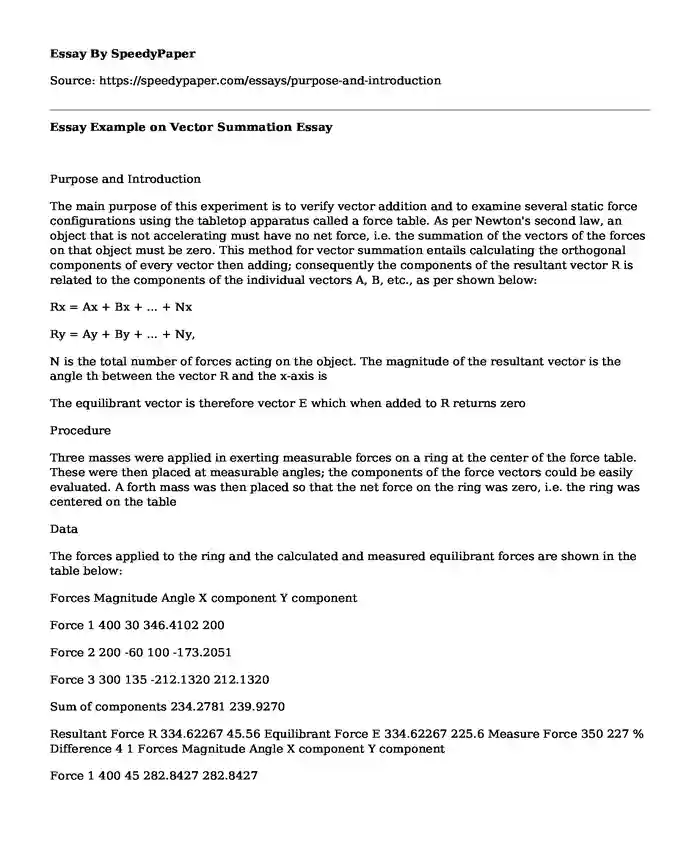
| Type of paper: | Essay |
| Categories: | Mathematics |
| Pages: | 2 |
| Wordcount: | 476 words |
Purpose and Introduction
The main purpose of this experiment is to verify vector addition and to examine several static force configurations using the tabletop apparatus called a force table. As per Newton's second law, an object that is not accelerating must have no net force, i.e. the summation of the vectors of the forces on that object must be zero. This method for vector summation entails calculating the orthogonal components of every vector then adding; consequently the components of the resultant vector R is related to the components of the individual vectors A, B, etc., as per shown below:
Rx = Ax + Bx + ... + Nx
Ry = Ay + By + ... + Ny,
N is the total number of forces acting on the object. The magnitude of the resultant vector is the angle th between the vector R and the x-axis is
The equilibrant vector is therefore vector E which when added to R returns zero
Procedure
Three masses were applied in exerting measurable forces on a ring at the center of the force table. These were then placed at measurable angles; the components of the force vectors could be easily evaluated. A forth mass was then placed so that the net force on the ring was zero, i.e. the ring was centered on the table
Data
The forces applied to the ring and the calculated and measured equilibrant forces are shown in the table below:
Forces Magnitude Angle X component Y component
Force 1 400 30 346.4102 200
Force 2 200 -60 100 -173.2051
Force 3 300 135 -212.1320 212.1320
Sum of components 234.2781 239.9270
Resultant Force R 334.62267 45.56 Equilibrant Force E 334.62267 225.6 Measure Force 350 227 % Difference 4 1 Forces Magnitude Angle X component Y component
Force 1 400 45 282.8427 282.8427
Force 2 200 -45 141.4214 -141.4214
Force 3 500 270 -9.1886E-14 -500
Sum of components 424.2641 -358.5786
Resultant Force R 555.498 -40.2 Equilibrant Force E 555.498 -139.8 Measure Force 550 140 % Difference 1 0 Forces Magnitude Angle X component Y component
Force 1 350 20 328.8924 119.7070
Force 2 200 315 141.4214 -141.4214
Force 3 500 250 -171.0100 -469.8463
Sum of components 299.3037 -.491.5606
Resultant Force R 575.5124 -58.66 Equilibrant Force E 575.5124 121.3 Measure Force 570 118 % Difference 1 3 Forces Magnitude Angle X component Y component
Force 1 300 25 271.8923 126.7854
Force 2 200 310 128.5575 -153.2089
Force 3 250 200 -234.9231 -85.5050
Sum of components 165.5237 -111.9284
Resultant Force R 199.8176 -34.07 Equilibrant Force E 199.8176 145.9 Measure Force 200 143 % Difference 0 2 Results/Conclusions
The results of this experiment are as shown in the table above. All the measured forces are just within 4 percent difference of the total calculated forces; therefore the conclusion is that the method used in the calculation of vector addition was accurate.
The first source of error is failing to ensure that the assorted weights and hangers are exactly the weight they are said to be having. It is imperative to ensure each and every weight and hanger is weighed precisely just like the machine that is being used to weigh them. The second source of error is failing to ensure that the force table is as level as it ought to be. More time should be used in testing the force table with marble while the strings attached are not attached.
Cite this page
Essay Example on Vector Summation. (2019, Nov 04). Retrieved from https://speedypaper.com/essays/purpose-and-introduction
Request Removal
If you are the original author of this essay and no longer wish to have it published on the SpeedyPaper website, please click below to request its removal:
- Free Essay on Public Internet Implementation
- Free Essay on Oscar Wilde Aesthetic
- Essay Example on PR Failures Case Studies
- The Race Debate in the Recitatif by the Toni Morrison
- Essay Sample on Fascinating and Inspiring Aspects of Artificial Intelligence
- Paper Example - Handling Problematic Employees at the Workplace
- Securing Critical Infrastructure: A Comprehensive Analysis of the U.S. Chemical Sector
Popular categories




